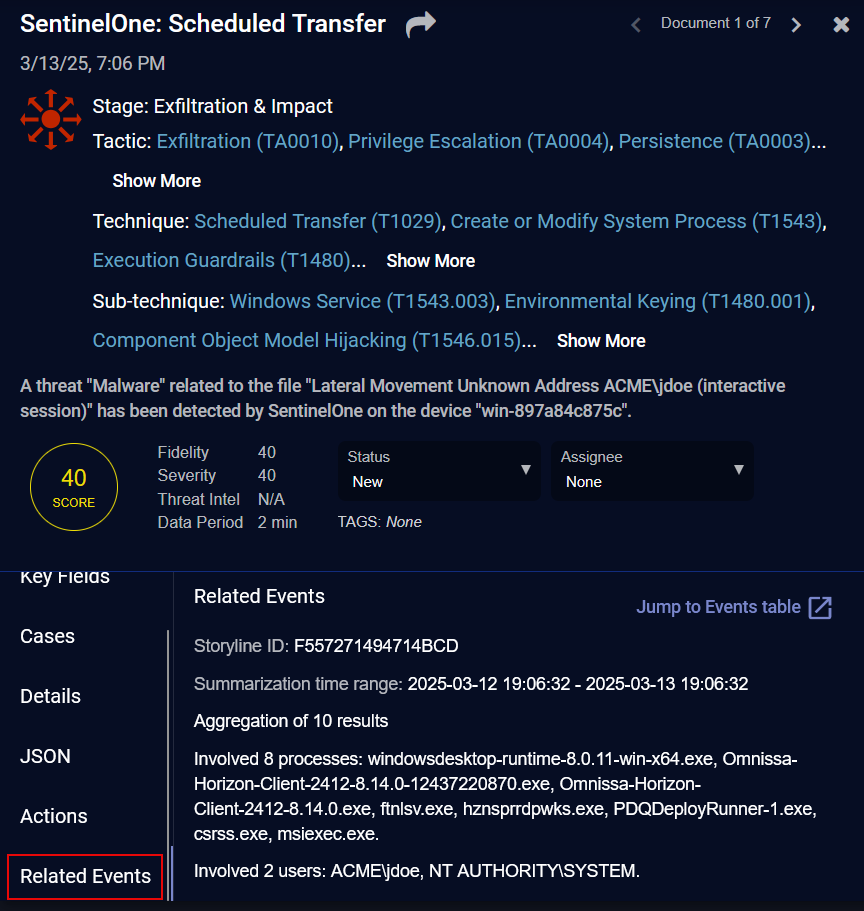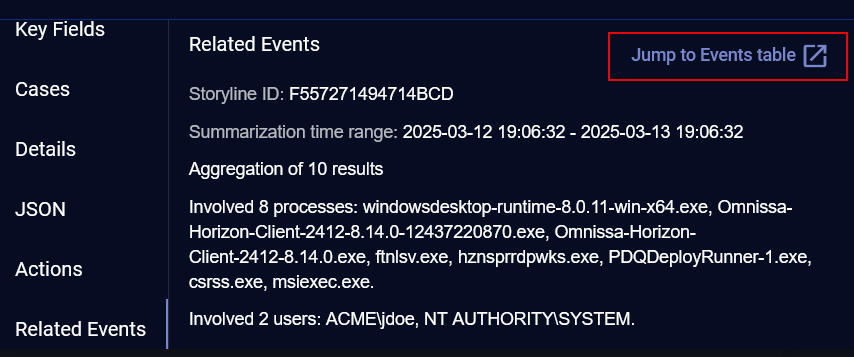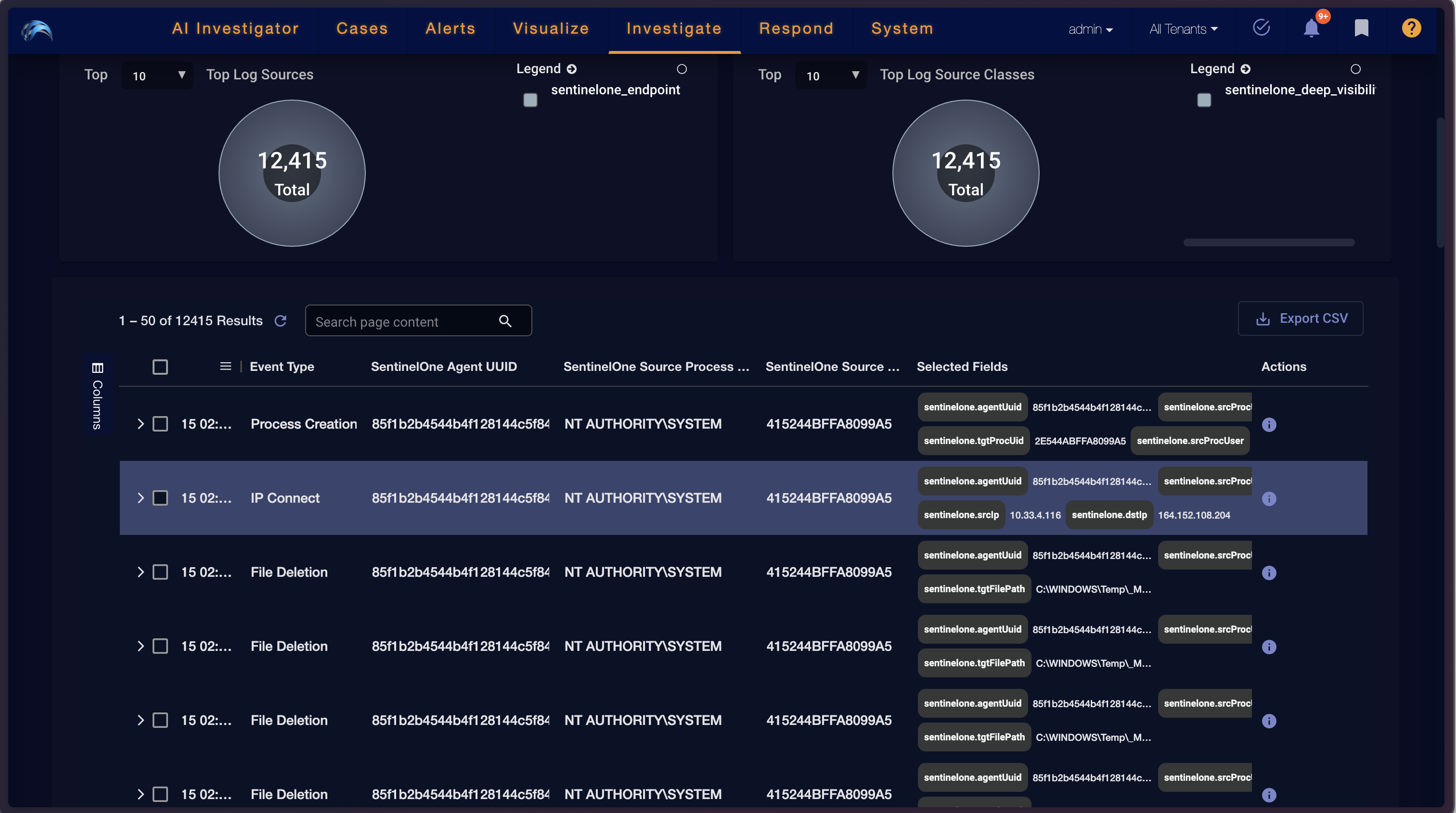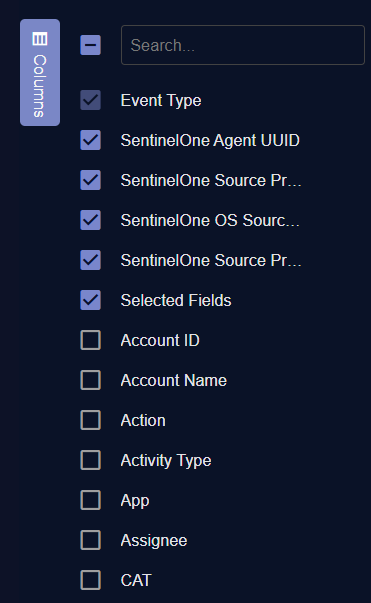Related Events for Alert Types
Related Events are available for the SentinelOne alert type. Related Events enhance Stellar Cyber's alert integration and provide more context for SentinelOne Deep Visibility events. For a security event, you can view when and how the security threat developed and you can investigate events on the Stellar Cyber platform without going to the SentinelOne console.
To support Related Events, this feature uses SentinelOne Threat Detection alerts as a source of information and SentinelOne Deep Visibility events as the data for high level summarization. Correlated Deep Visibility events must belong to the same tenant and organization.
Stellar Cyber performance may vary depending on the amount of Deep Visibility logs you ingest.
See the following:
Using the Related Events Tab
For a SentinelOne alert, click the Related Events tab to see a summary of related SentinelOne Deep Visibility events. The information in the tab provides a high level summarization of the events related to the alert and the entities involved.
The summarization only happens once. If there are no Deep Visibility events available when the data is ingested from SentinelOne, the summary may be empty. If new Deep Visibility events come in, the summary will not be updated.
To help you understand the high level scope of the security event, the following fields are displayed in Related Events:
-
Storyline ID—a unique ID associated with a security event and used to get SentinelOne Deep Visibility data
-
Summarization time range—the timestamps of the start and end of the summarization
-
Aggregation of—a count of the involved entities, such as process or user activities
-
Involved processes—the processes involved in the event, such as an endpoint process
-
Involved registries—the registries involved in the event, such as an endpoint registry
-
Involved hosts—the hosts involved in the event, such as a source host or destination host
-
Involved users—the users involved in the event, such as a user ID or user name
-
Involved files—the files involved in the event, such as a file name
-
Involved URLs—the URLs involved in the event, such as a URL
Using the Jump to Events Table
To help you understand the potential impact of the security event, click the link to Jump to Events table to view the events in Threat Hunting.
The Investigate | Threat Hunting page opens.
The events table contains fields for each event. The column headings on the left are common fields that exist in all SentinelOne Deep Visibility data. The Selected Fields on the right show important attributes that are presented dynamically in the table based on the event category.
The common fields in the Events table include: Event Time, Event Type, SentinelOne Agent UUID, SentinelOne Source Process User, SentinelOne OS Source Process UID, and SentinelOne Source Process Storyline ID.
The Selected Fields are based on each event category as follows:
|
Event Category |
Column Headings for the Selected Fields for this Event Category |
|---|---|
| Cloud Activity | Event Outcome Result, Event Outcome Reason, External Threat Value |
| Cross Process | Target Process Relation, Source Process UID, Source Process Command Line, Target Process UID, Target Process Command Line |
| Command Script | Agent UUID, Source Process UID, OS Source Process UID, Command Script Content, Source Command Script, Source Process Command Line |
| DNS | Agent UUID, Source Process UID, OS Source Process UID, DNS Request, DNS Request |
| Driver | Agent UUID, Source Process UID, Target File Path, Driver Load Verdict |
| File | Agent UUID, Source Process UID, OS Source Process UID, Target File Path, Target File Old Path, Target File Size |
| Firmware | Agent UUID, Source Process UID, OS Source Process UID |
| Identity | Actor Alternate ID, Actor Display Name, Login Account Name |
|
Indicators |
Agent UUID, Source Process UID, OS Source Process UID, Indicator Name, Indicator Category, Indicator Description, Indicator Metadata |
|
IP |
Agent UUID, Source Process UID, OS Source Process UID, Source IP Address, Source Port Number, Destination IP Address, Destination Port Number, Network Direction, Network Connection Status |
|
Logins |
Agent UUID, Source Process UID, OS Source Process UID, Source Endpoint IP Address, Login User Name, Login Base Type |
|
Module |
Agent UUID, Source Process UID, OS Source Process UID, Module Path |
|
Named Pipe |
Agent UUID, Source Process UID, OS Source Process UID |
|
Process |
Agent UUID, Source Process UID, OS Source Process UID, Target Process UID, Source Process Command Line, Source Process User, Target Process Command Line, Target Process User |
|
Registry |
Agent UUID, Source Process UID, OS Source Process UID, Registry Key Path, Registry Value |
|
Scheduled Task |
Agent UUID, Source Process UID, OS Source Process UID, Task Name, Task Path |
|
Threat Intelligence Indicators |
Agent UUID, Source Process UID, OS Source Process UID, TI Indicator Source, TI Indicator Value |
|
URL |
Agent UUID, Source Process UID, OS Source Process UID, URL Address, URL Action |




